Hi Andy,
This isn't my field and there is sure to be someone better able to answer this but I hope the following comments might be generally helpful.
Firstly a caveat, you don't say how big your box is, we don't know anything about the coloured glass you want to light and we don't know if the box has to be self powered (batteries) or can be supplied from the mains.
Secondly, LEDs are generally relatively small point sources with a narrow viewing angle, i.e they project a narrow beam of light. You may, depending on the size of the box and colour and transmissivity of the glass, need more than 9 to get the "even spread of light" you require.
Thirdly, LEDs are not terribly bright compared to general lighting levels so you may not get the desired effect unless you are viewing the piece in subdued light. Although LEDs are in the region of 10 times as efficient as GLS tungsten bulbs in converting electrical power to light, the power they can handle is much smaller. The ones noted below are rated at 30mA at 3.2V each which equals less than 0.1 watt of power input but may, because of their greater efficiency, emit about the same quantity of light as would a 1W GLS bulb. The LED concentrates that light into a beam whereas the typical GLS bulb radiates its light in (nearly) all directions. If the LED and GLS lamp were of equal brightness the LED would appear brighter when you look into the beam but would only light the area within the beam whereas the GLS lamp would light an area all around the lamp to a lower intensity.
Having said all that if you want to experiment and bought your bits from say Maplin ( I have no connection but they have a convenient website) the following gives you an idea of what you might try:
10 no 5mm Superbright White LEDs at £1.59, Maplin Order Code: N21BY. Data is as follows
Luminous Intensity Iv 6000mcd Min 7000mcd Typical
Viewing angle: 20°
Forward voltage: Vf 3.2V Typical 3.6V Max
(The Maplin site says these LEDs need 3.5v to work)
Continuous forward current: 30mA
You need to supply them with low voltage DC limiting the voltage to prevent too many watts cooking them. They use up batteries fairly quickly so you might want to use a mains adapter
DC Multi-Voltage 0.5A Regulated Power Supply at £15.99, Maplin Order Code: UG01B. Data is
500mA max current output
Selectable output voltage - DC 1.5 - 3 - 4.5 - 6 - 7.5 - 9 - 12V
You would set this to 4.5V and connect the LEDs in parallel across the 4.5V supply, ensuring the correct polarity. In order to limit the current through each LED to 30mA use a 47 Ohm resistor in series with each LED. The total power in the 10 LEDs should be about 300mA and about 120mA should be dissipated in the resistors making about 420 mA total, i.e. within the capacity of the DC adapter.
10 no 47 ohm 1/8th watt (or larger) resistors e.g Maplin Metal Film 0.6W Resistors at £0.15 each.
If you were to use 2000 mAH rechargeable AA batteries in lieu of the mains adapter you might get 4 to 5 hours before recharging them although the light output may drop off quite a lot before the 5 hours was up.
Hope this gives you some feel for what the LEDs might give you.
Regards
Graham,
 I was thinking about distributing about nine white LEDs across the side in order to get an even spread of light. Any help on how to set this up and power consumption etc. would be greatly appreciated.
I was thinking about distributing about nine white LEDs across the side in order to get an even spread of light. Any help on how to set this up and power consumption etc. would be greatly appreciated.
































